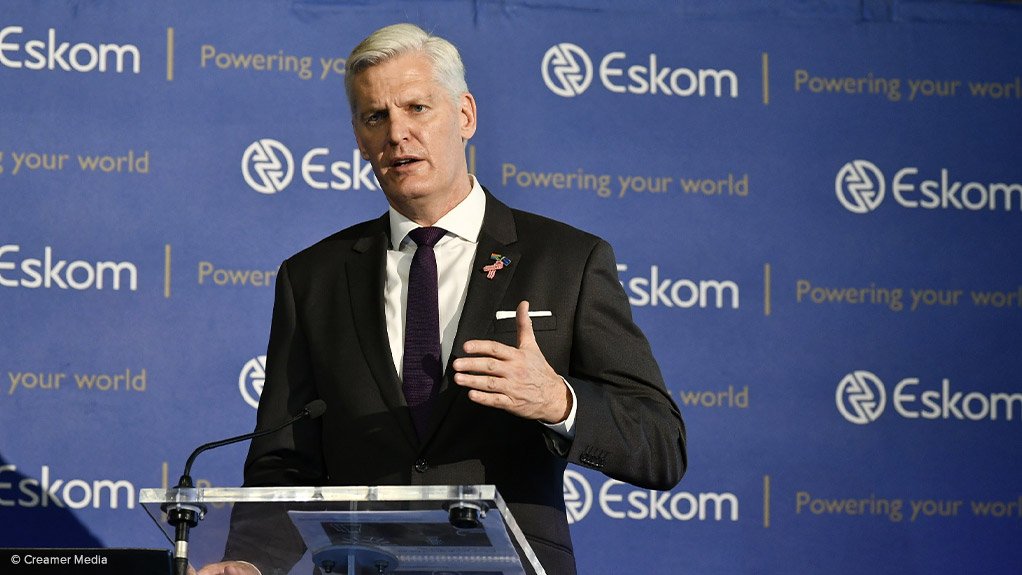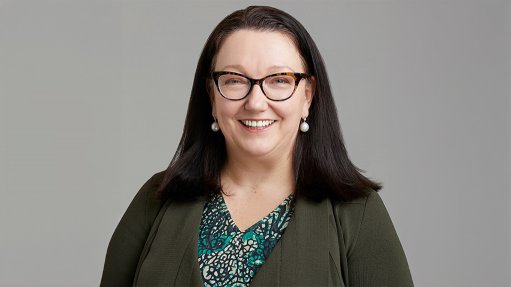De Ruyter backs call for lifting of licensing cap on distributed generators to 50 MW
Eskom CEO Andre de Ruyter says the State-owned utility is fully supportive of moves by large customers to develop distributed generation plants to power their operations, as well as growing calls to lift the licensing threshold from 1 MW to 50 MW so as to accelerate these investments.
South Africa, he told participants in an ENSafrica webinar on Tuesday, faced an ongoing supply crunch that could not be closed by the procurement of 13 800 MW of new utility scale capacity alone, as catered for by the Ministerial determinations gazetted to unlock investments in line with the Integrated Resource Plan.
Given the age and underperformance of Eskom’s coal fleet, the utility was currently able to reliably supply only 28 000 MW against an average daily demand of 34 000 MW – this despite a theoretical nameplate of more than 40 000 MW.
In addition, some 10 000 MW of its existing capacity would be decommissioned by 2030, leaving a supply shortfall of some 16 000 MW in the absence of any demand growth and any repowering of the decommissioned plant.
Besides government programmes to procure additional capacity in line with the determinations, Eskom was also testing the market for repurposing and repowering proposals for three powers stations, including repowering using renewables, imported gas and even hydrogen.
Nevertheless, De Ruyter said Eskom was in favour of opening up the network to “support customer-funded capacity” that could help address the immediate supply/demand gap and reduce the risk of load-shedding.
He also argued in favour of lifting the country’s licensing-exemption threshold for distributed generation investments from 1 MW to 50 MW in line with a recent analysis showing that such a move could release 5 000 MW or more of additional capacity within five years.
The analysis was conducted by Meridian Economics and was based on an industry survey conducted by EE Business Intelligence, which showed that the country’s restrictive regulatory framework was a major impediment to investment.
It concluded that, if the threshold for licensing projects was lifted to 50 MW or higher, there would be significant additional uptake, which would help ease pressure on the network.
The analysis accords with international experience in Australia, India and Vietnam, as well as a 2020 Council for Scientific and Industrial Research report, which placed “customer response at scale” at the front end of a multistep load-shedding recovery plan.
De Ruyter argued, however, that the tariff structure itself would need to be overhauled to reflect the fact that Eskom would be playing the role of a “giant battery”, the cost of which required fair compensation.
During recent National Energy Regulator of South Africa (Nersa) consultations the utility triggered much debate and pushback when it proposed a tariff restructuring model that more evenly balanced sales and capacity charges.
De Ruyter also held up the raising of the licensing cap as one of several actions that could be taken immediately to mitigate the potential negative effects on industry of a steady migration to cost-reflective tariffs.
He argued that a series of adverse tariff determinations by Nersa had resulted in a cumulative revenue shortfall of R370-billion since 2006 and was at the centre of the surge in its borrowings to the current unsustainable level of about R450-billion.
Eskom agreed that an immediate rise in the tariff to cost-reflective levels would be too much of a shock for the economy to bear. Instead, it favoured a “gradual migration” which would entail three years of double-digit increases, followed by inflation-type hikes.
Besides more “own generation” by large customers to offset the hikes, De Ruyter suggested that mining and industrial customers could be further protected by:
- removing the prevailing R8-billion subsidy paid by industrial customers in the current tariff;
- reintroducing tax incentives to support energy efficiency investments; and
- concluding negotiated pricing agreements with energy intensive users to mitigate the increases.
Poor customers, meanwhile, could be protected by raising the monthly free basic electricity threshold from 50 kWh to 100 kWh.
De Ruyter argued that, even after such an adjustment, Eskom’s tariff would remain low, at about US$0.13/kWh, when benchmarked against a range of industrial, developing and African countries.
He even went as far as to suggest that companies producing in South Africa and selling their products in hard currencies should benchmark some of their inputs, such as electricity, on a dollar-denominated basis so as to have the “reality of the exchange rate built into the equation”.
In so doing, the country’s mining and industrial strategy would not be based on taxpayer-subsidised electricity tariffs, he added.
Comments
Press Office
Announcements
What's On
Subscribe to improve your user experience...
Option 1 (equivalent of R125 a month):
Receive a weekly copy of Creamer Media's Engineering News & Mining Weekly magazine
(print copy for those in South Africa and e-magazine for those outside of South Africa)
Receive daily email newsletters
Access to full search results
Access archive of magazine back copies
Access to Projects in Progress
Access to ONE Research Report of your choice in PDF format
Option 2 (equivalent of R375 a month):
All benefits from Option 1
PLUS
Access to Creamer Media's Research Channel Africa for ALL Research Reports, in PDF format, on various industrial and mining sectors
including Electricity; Water; Energy Transition; Hydrogen; Roads, Rail and Ports; Coal; Gold; Platinum; Battery Metals; etc.
Already a subscriber?
Forgotten your password?
Receive weekly copy of Creamer Media's Engineering News & Mining Weekly magazine (print copy for those in South Africa and e-magazine for those outside of South Africa)
➕
Recieve daily email newsletters
➕
Access to full search results
➕
Access archive of magazine back copies
➕
Access to Projects in Progress
➕
Access to ONE Research Report of your choice in PDF format
RESEARCH CHANNEL AFRICA
R4500 (equivalent of R375 a month)
SUBSCRIBEAll benefits from Option 1
➕
Access to Creamer Media's Research Channel Africa for ALL Research Reports on various industrial and mining sectors, in PDF format, including on:
Electricity
➕
Water
➕
Energy Transition
➕
Hydrogen
➕
Roads, Rail and Ports
➕
Coal
➕
Gold
➕
Platinum
➕
Battery Metals
➕
etc.
Receive all benefits from Option 1 or Option 2 delivered to numerous people at your company
➕
Multiple User names and Passwords for simultaneous log-ins
➕
Intranet integration access to all in your organisation





















